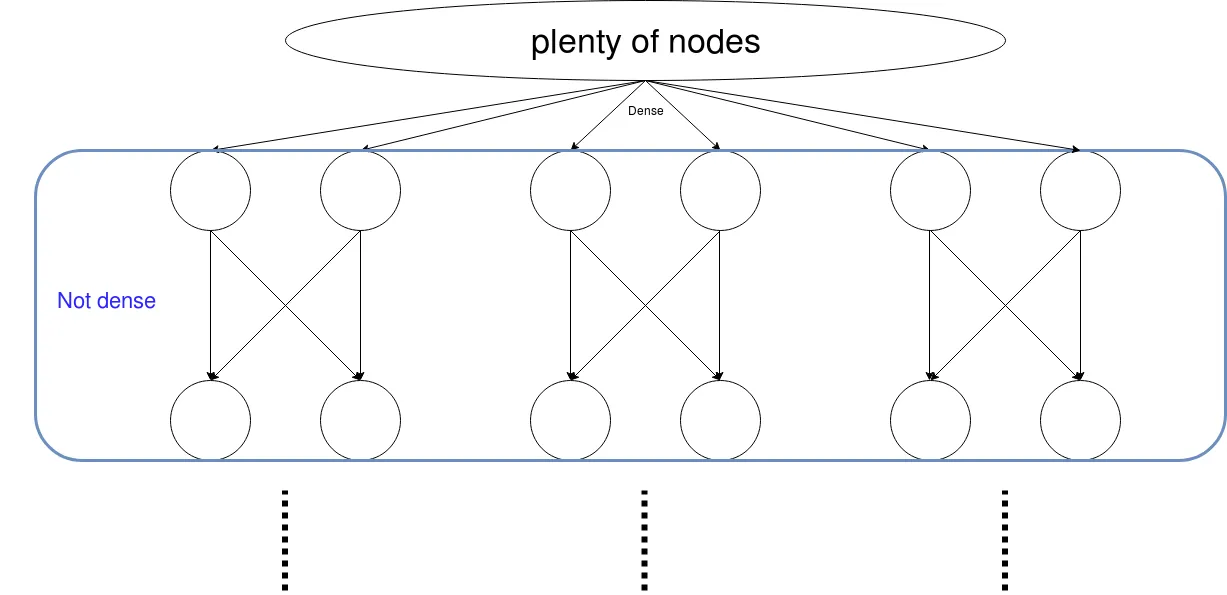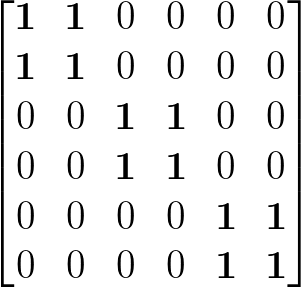Tensorflow自定义层:使用可训练参数创建稀疏矩阵
6
- Marko Karbevski
5
那么你具体想要什么?你想知道如何在TensorFlow中创建稀疏矩阵,还是你遇到了什么问题? - eugen
@eugen 是的,我想创建一个稀疏可训练矩阵,至少要遵循上述描述的模式。 - Marko Karbevski
好的,我已经发布了一个答案,请查看。 - eugen
我相信有更好的方法,但你可以创建一个密集权重矩阵,并在激活函数之前将其乘以你的分块对角矩阵。这样,所有与分块对角矩阵中位置0相关联的权重的梯度都将被清零,权重不会被改变。 - foglerit
@foglerit 这会使事情变得相当慢。TF 在优化时仍会考虑所有变量,对吗? - Marko Karbevski
2个回答
3
我已经编写了这样一层:
https://github.com/ArnovanHilten/GenNet/blob/master/GenNet_utils/LocallyDirectedConnected_tf2.py
它以稀疏矩阵作为输入,并允许您决定如何在层之间进行连接。该层使用稀疏张量和矩阵乘法。
- Arno
2
编辑
所以评论是:这是一个可训练的对象吗?
答案:不是。您目前不能使用稀疏矩阵并使其可训练。相反,您可以使用掩码矩阵(请参见末尾)。
但是,如果您需要使用稀疏矩阵,则只需使用tf.sparse.sparse_dense_matmul()或tf.sparse_tensor_to_dense(),其中您的稀疏矩阵与密集矩阵交互。我从此处获取了一个简单的XOR示例,并将密集矩阵替换为稀疏矩阵:
#Declaring necessary modules
import tensorflow as tf
import numpy as np
"""
A simple numpy implementation of a XOR gate to understand the backpropagation
algorithm
"""
x = tf.placeholder(tf.float32,shape = [4,2],name = "x")
#declaring a place holder for input x
y = tf.placeholder(tf.float32,shape = [4,1],name = "y")
#declaring a place holder for desired output y
m = np.shape(x)[0]#number of training examples
n = np.shape(x)[1]#number of features
hidden_s = 2 #number of nodes in the hidden layer
l_r = 1#learning rate initialization
theta1 = tf.SparseTensor(indices=[[0, 0],[0, 1], [1, 1]], values=[0.1, 0.2, 0.1], dense_shape=[3, 2])
#theta1 = tf.cast(tf.Variable(tf.random_normal([3,hidden_s]),name = "theta1"),tf.float64)
theta2 = tf.cast(tf.Variable(tf.random_normal([hidden_s+1,1]),name = "theta2"),tf.float32)
#conducting forward propagation
a1 = tf.concat([np.c_[np.ones(x.shape[0])],x],1)
#the weights of the first layer are multiplied by the input of the first layer
#z1 = tf.sparse_tensor_dense_matmul(theta1, a1)
z1 = tf.matmul(a1,tf.sparse_tensor_to_dense(theta1))
#the input of the second layer is the output of the first layer, passed through the
a2 = tf.concat([np.c_[np.ones(x.shape[0])],tf.sigmoid(z1)],1)
#the input of the second layer is multiplied by the weights
z3 = tf.matmul(a2,theta2)
#the output is passed through the activation function to obtain the final probability
h3 = tf.sigmoid(z3)
cost_func = -tf.reduce_sum(y*tf.log(h3)+(1-y)*tf.log(1-h3),axis = 1)
#built in tensorflow optimizer that conducts gradient descent using specified
optimiser = tf.train.GradientDescentOptimizer(learning_rate = l_r).minimize(cost_func)
#setting required X and Y values to perform XOR operation
X = [[0,0],[0,1],[1,0],[1,1]]
Y = [[0],[1],[1],[0]]
#initializing all variables, creating a session and running a tensorflow session
init = tf.global_variables_initializer()
sess = tf.Session()
sess.run(init)
#running gradient descent for each iterati
for i in range(200):
sess.run(optimiser, feed_dict = {x:X,y:Y})#setting place holder values using feed_dict
if i%100==0:
print("Epoch:",i)
print(sess.run(theta1))
输出结果为:
Epoch: 0
SparseTensorValue(indices=array([[0, 0],
[0, 1],
[1, 1]]), values=array([0.1, 0.2, 0.1], dtype=float32), dense_shape=array([3, 2]))
Epoch: 100
SparseTensorValue(indices=array([[0, 0],
[0, 1],
[1, 1]]), values=array([0.1, 0.2, 0.1], dtype=float32), dense_shape=array([3, 2]))
所以唯一的方法是使用掩码矩阵。你可以通过乘法或tf.where来使用它。 1) 乘法:你可以创建所需形状的掩码矩阵,并将其与权重矩阵相乘:
mask = tf.Variable([[1,0,0],[0,1,0],[0,0,1]],name ='mask', trainable=False)
weight = tf.cast(tf.Variable(tf.random_normal([3,3])),tf.float32)
desired_tensor = tf.matmul(weight, mask)
2) tf.where
mask = tf.Variable([[1,0,0],[0,1,0],[0,0,1]],name ='mask', trainable=False)
weight = tf.cast(tf.Variable(tf.random_normal([3,3])),tf.float32)
desired_tensor = tf.where(mask > 0, tf.ones_like(weight), weight)
希望这能有所帮助。
您可以通过使用稀疏张量来实现此操作,如下所示:
SparseTensor(indices=[[0, 0], [1, 2]], values=[1, 2], dense_shape=[3, 4])
输出结果为:
[[1, 0, 0, 0]
[0, 0, 2, 0]
[0, 0, 0, 0]]
您可以在这里查阅更多关于稀疏张量的文档:
https://www.tensorflow.org/api_docs/python/tf/sparse/SparseTensor
希望对您有所帮助!
- eugen
1
这是一个可训练的对象吗? - Marko Karbevski
网页内容由stack overflow 提供, 点击上面的可以查看英文原文,
原文链接
原文链接

